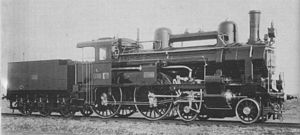kkStB 6
| kkStB 6 BBÖ 6 / ČSD 264.0 / PKP Pd12 |
|
|---|---|
|
kkStB 6.05
|
|
| Numbering: | kkStB 6.01–68 BBÖ 6.15–58 (from kkStB, with gaps) ČSD 264.001–028 PKP Pd12-1–9 |
| Number: | kkStB: 68 BBÖ: 20 (from kkStB) ČSD: 28 (from kkStB) PKP: 9 (from kkStB) |
| Manufacturer: | Floridsdorf , Wr. Neustadt , StEG |
| Year of construction (s): | 1894-1898 |
| Retirement: | BBÖ: until 1932 ČSD: until 1938 |
| Type : | 2'B n2v |
| Gauge : | 1435 mm ( standard gauge ) |
| Length: | 10,007 mm |
| Fixed wheelbase: | 2,800 mm |
| Total wheelbase: | 7,300 mm |
| Empty mass: | 50.1 t |
| Service mass: | 56.1 t |
| Friction mass: | 28.8 t |
| Top speed: | 90 km / h |
| Driving wheel diameter: | 2,120 mm |
| Impeller diameter front: | 1,024 mm |
| Number of cylinders: | 2 |
| HD cylinder diameter: | 500 mm |
| LP cylinder diameter: | 740 mm |
| Piston stroke: | 680 mm |
| Boiler overpressure: | 13 atm |
| Number of heating pipes: | 205 |
| Grate area: | 2.90 m² |
| Radiant heating surface: | 11.00 m² |
| Tubular heating surface: | 144.50 m² |
| Tender: | 9 , 56 , 156 , 256 , 76 , 86 , 88 |
The steam locomotive series kkStB 6 was a fast - Tender Lokomotiv series of kk Austrian National Railways (kkStB).
history
The kkStB series 6 was the first creation by Karl Gölsdorf in the kkStB design office. Since the express train locomotives used in the 1890s were too weak due to increasing train weights, Gölsdorf designed the considerably stronger class 6 as a compound machine to replace the 4 series . The boiler was half a meter higher than row 4. Row 6 was a resounding success. She drove without problems at 130 km / h, continuous power of 800 hp and peak power of 1000 hp. On the flat she pulled 210 t at 100 km / h; on a 10 ‰ slope, the speed did not drop below 58 km / h. The maximum speed allowed was 90 km / h. A total of 68 units were delivered by the Floridsdorf locomotive factory , the Wiener Neustädter Lokomotivfabrik and the StEG locomotive factory .
With the number 6, the travel time Vienna - Prague could be reduced from twelve to eight hours! The locomotives were also used on the Vienna – Eger , Prague – Linz and Vienna – Salzburg routes. Of course, they also hauled the Orient Express , the Ostend Express and the spa trains to Karlsbad .
After the First World War , 20 pieces came to the Austrian Federal Railways (BBÖ). 28 units formed the 264.0 series on the Czechoslovak State Railways (ČSD) . At the Polish State Railways AG (PKP) nine pieces were classified as the Pd12 series. The remaining machines were war losses or were eliminated before they were included in the series scheme of the various railway companies. The BBÖ withdrew their machines until 1932, the ČSD until 1938.
literature
- Locomotive types of the kk landesbef. Machine factory in Vienna of the priv. Austro-Hungarian State Railway Company . M. Engel & Sohn, kk Hof-Buchdruckerei und Hof-Lithographie, Vienna 1888.
- Karl Gölsdorf: Locomotive construction in old Austria 1837–1918 . Slezak publishing house, Vienna 1978, ISBN 3-900134-40-5 .
- Helmut Griebl, Josef Otto Slezak, Hans Sternhart: BBÖ Lokomotiv-Chronik 1923–1938 . Slezak publishing house, Vienna 1985, ISBN 3-85416-026-7 .
- Alfred Horn: The locomotive family of the Austrian class 6 . In: Lok-Magazin . No. 58 . Franckh'sche Verlagshandlung, W. Keller & Co. , 1973, ISSN 0458-1822 , p. 25-33 .
- Bernhard Schmeiser: Haswell, StEG and Mödling locomotives 1840–1929 (reprint) . Slezak publishing house, Vienna 1992, ISBN 3-85416-159-X .
- Heribert Schröpfer: Locomotives for Austrian railways - steam locomotives BBÖ and ÖBB . alba, Düsseldorf 1989, ISBN 3-87094-110-3 .
- Johann Stockklausner: Steam company in old Austria . Slezak Verlag, Vienna 1979, ISBN 3-900134-41-3 .
- Johann Blieberger, Josef Pospichal: The kkStB traction vehicles, volume 1. The rows 1 to 228 . bahnmedien.at, 2008, ISBN 978-3-9502648-0-7 .
